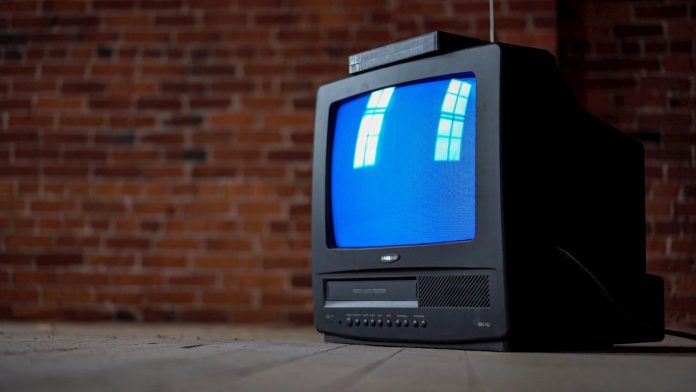When you put a tape into a VCR, it disappears into the machine’s body and is pulled inside complex mechanisms that click and whir in an invisible process.
The image, sound and timing signals are all invisible magnetic pulses on a plastic strip. There’s also a smaller version of the cassette used in camcorders called S-VHS-C.
What is a VHS Tape?
VHS is a videotape format that was dominant in the home video market throughout the 1980s. The VHS tape was popular for recording family vacations, weddings, and other special events. VHS was a great improvement over the previous generation of video tape formats like Betamax. VHS was less expensive and offered more storage space. It was also easy to use with a standard VCR and was backward compatible.
A VHS tape is a rectangular cassette with two reels that spin in opposite directions. The cassette is opened by lifting a small hinged flap. When inserted into a VCR, the spindles pull the tape towards the back of the machine and wind it around the video drum and a separate audio head. The tape then records the signal from the television and is playable later on.
The tape is very thin, making it susceptible to physical damage. This can result in poor video quality or even complete loss of the recording. To prevent this, the VHS tapes should be carefully assessed prior to playing them and any physical issues should be remedied.
When a VHS tape is damaged, it is recommended that a professional service be used to have the content digitized. The quality of the digital file can be adjusted to meet the needs and budget of the organization. The organization can choose low, medium, or high quality based on the value of the material and its need for future editing and corrections.
Some VHS tapes may require a high level of digitization for them to be useful in the future. This is because the physical condition of the tape may be deteriorating quickly and it will need to be digitized soon for preservation purposes.
How Does a VHS Tape Work?
When we think of VHS tapes, we often associate them with an era that is long gone. But, even though these analog tapes are now obsolete they still contain valuable information that can be digitized for future use. The process of digitization can be a complicated and time consuming one, but it is worth the effort. This process involves moving the content from an analog format to a digital one so that it can be edited and accessed in the future.
A typical VHS cassette consists of an outer shell with a spring-loaded door. Inside there are two spools which hold the tape. There are also two spring-loaded locks to prevent the tape from unrolling, and low-friction rollers to guide the tape. The tape itself is 800 feet long and 1/2 inch wide and consists of oxide-coated mylar film.
The spools and the low-friction rollers are controlled by a series of metal gears, which are then passed onto a nylon roller and finally to the recording head. The record head is fed a magnetic signal which records the audio data on the tape. When the record head is played back, a read-out of that data takes place. The resulting signal is then fed to an erase head, which erases any previous recordings from the tape.
This is a common problem with analog tapes as they age, and it may be caused by several factors. Contaminants such as dust, smoke particles and fingerprints will cause a separation between the tape surface and the record heads which can result in momentary signal losses during playback. This can also be caused by a loss of lubricant, or by successive recordings that strip a layer from the tape’s surface.
When preparing a tape for digitization it is important to clean the tape and inspect it for damage. If possible, a replacement tape shell should be used instead of the original one to prevent damage during handling. Also, any labels on the cassette should be removed or re-adhered. Ideally, these labels should be placed in the recessed areas on the front and spine of the cassette shell, which are designed specifically for label placement.

What is a VHS Cassette?
VHS cassettes are plastic containers that contain a spool of magnetic tape used to store video content. They are played back using a device called a videocassette recorder (VCR), which reads the information on the tape and converts it into electrical signals that can be displayed on a television screen. The VCR also has a mechanism that allows it to record new content onto the tape.
When the tape is inserted into the cassette, it runs across metal rotating rollers at each end. This is referred to as the “print-through” process. The left reel is the supply reel, and the right is the take-up reel. The tape is held in place by a nylon guide roller for the supply reel and a metal post and cleaning pad for the take-up reel.
The spool of tape is also often labeled with a grade designation, such as standard grade, high grade, or extra-high grade. However, this grading system only applies to the specific brand of tape and cannot be relied upon as an indication of the quality of the tape itself.
In addition to the tape itself, there are several other components in a VHS cassette that must be properly maintained for optimal performance. The cassette shell should be clean and free of cracks, dents, and holes. The cassette tape should be inspected and replaced as necessary, as worn or damaged tape may cause additional problems for the VCR when it is playing back the tape.
Another important aspect of a VHS cassette is the tape cartridge. The tape must be firmly seated in the cartridge, and any plastic tabs should be firmly snapped into place. The cassette shell should also be free of any debris or splices. Splices should be avoided if possible, as they can cause damage to the tape and to the VCR. If a splice is needed, only the proper splicing tape should be used.
Finally, it is essential to have a test tape available for troubleshooting purposes. This will help to determine whether a problem is caused by the VCR, cassette, or tape itself, and will allow for more accurate treatment options to be pursued. For example, if the tape is displaying bands of noise lines that indicate tracking issues, a test tape can be used to determine whether a manual adjustment of the track is effective or if more invasive treatment is required.
What is a VHS Recorder?
A VHS recorder is a device used to play or record videotapes, including home movies. These devices can also be used to convert old tapes and digitize a tape to a digital format, which can then be played back on a computer or television. VHS recorders are still commonly available in stores such as movie rental shops, where they are often sold in conjunction with DVD players.
The first video tape recorders (VTRs) were used exclusively in professional environments, until the price of magnetic tape technology became affordable for home use in the 1970s. The first consumer-level analog videotape systems were based on the Betamax format, but JVC’s VHS system was eventually adopted as the standard for home video recording.
VHS tapes have a rectangular shape with two reels, one for the supply tape and one for the take-up tape. The cassette has an arrow printed on the side that points in the direction of playback, and can be used only with the arrow facing up. A tape inserted into a VHS recorder is automatically played in the correct direction, so that it may be used with any VCR.
There are five commands that can be executed on a VHS recorder: Play, which plays the movie; Rewind, for going backwards in the movie; Fast Forward, for moving faster through the movie; Stop, to make the movie stop; and Eject, to remove the tape from the recorder. A VHS recorder can play either NTSC or PAL-formatted tapes.
When a VHS-C (compact) tape is inserted into a VCR, an adapter spanning the gap between the tape path distance of a normal full-size cassette hub and the gearing of the recorder engages the small tape hub of the compact cassette. The adapter has a mechanical, but often motorized, mechanism with a battery that drives the head drum and erase heads of the recorder.
If an individual is converting a collection of VHS tapes to digital, he or she should be sure that all problems that might affect the quality of the video are remedied prior to digitization. Otherwise, the errors will be transmitted to the digital copy of the tape. Fortunately, most of these problems can be corrected through a series of simple tests.




